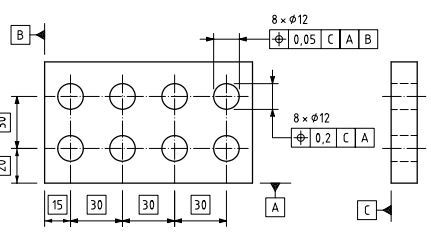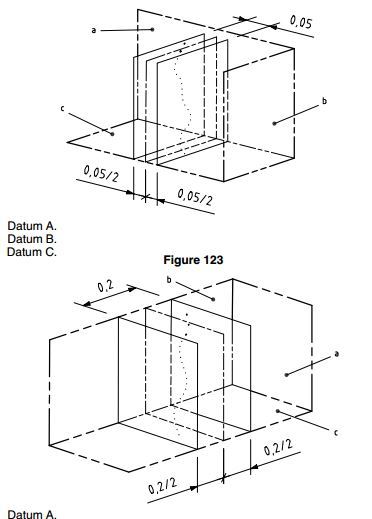The question I have is regarding the datum setup and the interpretation of tolerance zones established by them for bi-directional position tolerance frame setup. Attached is the illustrations from ISO 1101:2004 version of standards. ASME seems to have the same interpretation in regards to bi-directional position tolerances.
Typically at my company we use positional tolerance in it's full capacity with a diametrical symbol for a cylindrical tolerance zone when applicable for a cylindrical feature of size but it's eating me up not being able to fully grasp what seems to be a simple answer that I'm missing for this scenario.
Most of the examples I see have 3 datums setup for bi-directional. I understand the tolerance frame setup for cylindrical tolerance zones and 3 datums in both bi-direction..but it seems that using only 2 datums for one of the directions is interpreted the same according to the tolerance zone definition so I'm a bit confused. Is 3 datums necessary when 2 theoretically seem that they would do where one controls the orientation and the other the location with respect to the referenced datum? Or like some orientation tolerances, is the first 2 for establishing the tolerance zone and its orientation with respect to the 2nd datum and the 3rd locates it?
Been thinking on this subject far longer than I should be...


Typically at my company we use positional tolerance in it's full capacity with a diametrical symbol for a cylindrical tolerance zone when applicable for a cylindrical feature of size but it's eating me up not being able to fully grasp what seems to be a simple answer that I'm missing for this scenario.
Most of the examples I see have 3 datums setup for bi-directional. I understand the tolerance frame setup for cylindrical tolerance zones and 3 datums in both bi-direction..but it seems that using only 2 datums for one of the directions is interpreted the same according to the tolerance zone definition so I'm a bit confused. Is 3 datums necessary when 2 theoretically seem that they would do where one controls the orientation and the other the location with respect to the referenced datum? Or like some orientation tolerances, is the first 2 for establishing the tolerance zone and its orientation with respect to the 2nd datum and the 3rd locates it?
Been thinking on this subject far longer than I should be...


